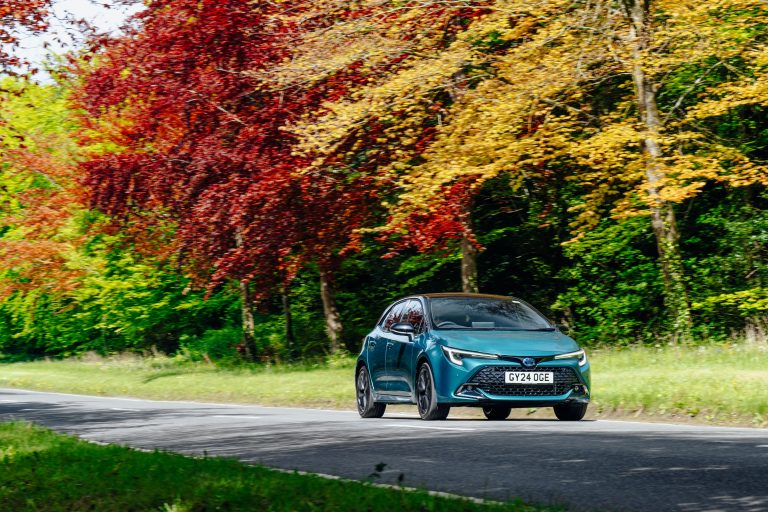Toyota technology for a new hybrid electric generation
More power and more rewarding performance are the headline qualities of the fifth generation of Toyota’s market-leading hybrid electric technology, delivered with even more efficient fuel consumption and emissions. The comprehensively revised system, which debuted earlier this year in the new Corolla range, in fact targeted a wider range of benefits – goals which were successfully achieved through Toyota’s commitment to continuous improvement.
Each element in the electrified powertrain came under close scrutiny to see where gains could be made, with a focus that extended beyond efficiency to better dynamic performance and acceleration feel, reducing noise and vibration in the cabin, preserving load space in the boot and enhancing driving stability. Key components have been redesigned, making them smaller and lighter; new techniques have been adopted for cooling and lubrication; more space-efficient packaging has been achieved; and recalibration of the throttle and transmission has produced more linear acceleration.
Where performance benchmarks* are concerned, total power from the 1.8-litre system in the new Corolla is 138bhp, bringing a 1.8-second reduction in the 0-62mph time to 9.1 seconds. For the 2.0-litre system, total output has risen to 193bhp and half a second has been shaved from the 0-62mph time, taking it down to 7.4 seconds.
CO2 emissions are from 100g/km for the 1.8-litre and 98g/km for the 2.0-litre, with fuel economy from 64.2mpg.
The wide-ranging benefits will be delivered across the next generation of Toyota hybrid electric models, including the all-new C-HR to be revealed later in 2023.
*All figures WLTP combined cycle, new Corolla Icon Hatchback with 16-inch wheels. For full range data visit media.toyota.co.uk.
Smaller, lighter, smarter
The fifth generation system features a new “downsized” transaxle that’s compact and lightweight, with a new multi-axis motor-generator and a new-design power control unit (PCU) that is installed directly above. The high-output motor-generator has new internals that support better fuel efficiency and dynamic performance, and a new stator coil winding method has helped reduce the motor’s size.
Energy losses in the PCU have been reduced and its inverter runs at a higher frequency, further reducing operating noise. The attention to detail in the mission to save weight and space includes a smaller differential containing smaller gears; this required a reprofiled tooth design, with a thicker “root” to ensure no reduction in component strength. A new double-sided cooling system for the PCU has reduced internal losses – down by 14 per cent in the 1.8-litre system and 6.1 per cent in the 2.0-litre.
Using CAE design techniques, Toyota has reduced the weight of the transaxle case by 20 per cent; adopting new materials has helped bring down the unit’s overall mass by 15 per cent.
Where lubrication is concerned, using a lower viscosity oil (50 per cent lower than in a conventional automatic transmission) contributes to the system’s fuel efficiency, reducing energy losses through internal friction, while the switch to a dry sump allows for a lower dynamic transmission fluid level, optimising gear and bearing lubrication to give enhanced transmission efficiency.
Hybrid battery
The new lithium-ion hybrid battery is smaller and lighter but has a higher output – qualities that contribute to both the car’s dynamic performance and its fuel efficiency.
Compared to the battery deployed in the fourth generation system, unit weight has been reduced by 14 per cent while power output has increased by 14 per cent. Optimising the battery’s cooling path has helped prevent deterioration caused by temperature fluctuations and preserve battery life. Being housed beneath the rear seats, the battery unit doesn’t intrude in the car’s load space.
A more rewarding driving experience
The advances made with the fifth generation hybrid system include improvements in driveability, capturing the potential of the higher power contribution from the battery. Notably, the driver experiences a better relationship between their use of the throttle and vehicle response with more consistent, predictable and controllable performance. A better acceleration feel makes for more confident driving.
This has been achieved by calibrating the throttle better to suit familiar driving scenarios, such as stop-start traffic and frequent changes in speed limits. The acceleration also adapts to up and downhill driving, synchronising the engine speed with the driver’s inputs to give a more natural feel and easier drive. Running at lower rpm also makes the system quieter when driving at highway speeds.
ENDS












